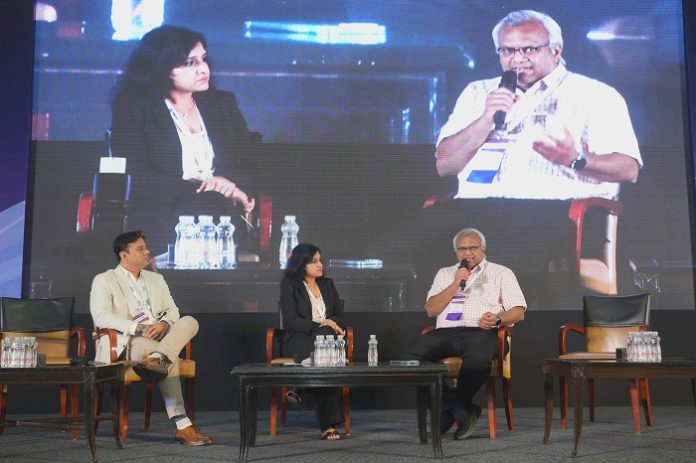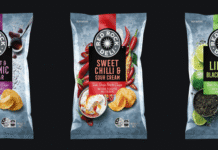
Paperization and sustainable packaging options were meaningfully discussed by the panel “From Concept to Shelf, to Recycling to Recyclates in the Design of Packaging,” at the maiden PACK.Nxt conference at Mumbai on 18 January 2024. The session was excellently moderated by plastic recycler Banyan Nation’s chief business officer, Rashi Agrawal.
PN Shridharr, general manager, of sustainable products and packaging, ITC, gave the example of the one-kilogram pack of Aashirvaad Atta for demonstrating the switch from plastic to paper packaging. “Paperization seems to be the trend globally. The key aspect of this switch from plastic to paper was enhancing the barrier properties of paper, which is a very porous material and cannot easily match the properties offered by plastic. What we did was reduce the overall amount of plastic in the packaging of the 1 kilogram pack of Aashirvaad Organic Atta to 40% by switching from a 100% plastic laminate to a mix of paper and plastic laminate.”
The biggest challenge that ITC had to overcome was to work on the way of handling the package and conduct a number of drop tests to ensure that it met the product handling and logistics requirements. “We also had a lot of support from our topmost management in meeting this goal,” he said adding, “ITC is trying to move secondary packaging from plastic to paper as it doesn’t require the same level of barrier properties. For Sunfeast biscuit packs, we have moved the secondary packaging to kraft paper packs.”
“Too Yum Foods has a gamut of product lines, where certain products are from our own brand and other brands are retailed as a part of Spencer’s Retail and Nature’s Basket,” said Subhra Sankha Nandi, head – packaging commercialization of Too Yum Foods which is a part of the RP-Sanjiv Goenka Group. The easiest way to contribute to the environment without changing much is to shift from plastic to paper packaging. “We have started targeting this with Karare (a type of baked snack) and potato chips in our product line and it will be gradually implemented across most of our products,” he said. “Our multigrain chips have four sharp edges – if we drastically reduce the thickness of plastic these sharp edges may end up opening the packs,” he added.
The company has made many changes in its secondary packaging, Nandi said, adding that these initiatives have helped in reducing the overall cost as well as overall consumption of paper. “For primary packaging, we have worked from the protection point of view while on secondary packaging we have worked on reducing paper consumption. We are under discussion with our partners to develop packaging from a sustainability point of view while keeping in mind the affordability and ease of availability of alternate materials,” he shared.
Lifecycle analysis helps define the scope and the boundaries of packaging, Shridharr said, adding that the overall global consumer conception that paper packaging is more environmentally friendly is driving the switch from plastic to paper packaging. “The recyclability of both paper and plastic packaging depends a lot on segregation at source. The key differentiator is that when you look at paper packaging, its raw material is naturally occurring, grown on farmlands and can be converted to farm manure,” he said.
“In addition, we have grown up seeing that paper is being collected and recycled,” he shared, adding that in the last 60-70 years, there has been a very well-settled value chain including the raddiwalas who collect newspaper and corrugated boxes from house to house. “A critical point of consideration while designing the packaging for products is to look at how to identify and send the packaging to the correct recycling stream,” he added.
Nandi suggested that we have to look at the recycling angle from all the verticals. Our prime focus while designing packaging solutions, as an industry, should be on cost-effectiveness and recyclability.
Shridharr informed the audience that ITC has a Life Sciences and Technology Centre in Bengaluru where one of the things that it is working on is monomaterial packaging. He quoted an international survey that reported that almost 42% of global packaging, including rigid and flexible packaging, is looking at paperization as an alternative.
The 2023 McKinsey Global Consumer Research on Consumer Perceptions shows that Indian consumers are willing to pay more if we communicate to them how sustainable the packaging is and what efforts the brand is making toward sustainable packaging options. Indian customers also opted for glass, paper and rigid packaging as the most sustainable packaging options, according to the report.
Shidharr also explained that the kind of paper that we use for paperboard packaging comes from growing specific kinds of trees and does not involve deforestation. There is no relation between the Indian paper industry and forests – “We have our own 20 million tons of paper production in India and every kilogram comes from farmers’ plantations, who use their non-food crop areas mainly for Eucalyptus and Casuarina,” he said.
“When we talk about paper versus plastic, we are looking at something sustainable that does not hamper our ecological balance,” Nandi said. “We are looking at plastic minimization, not at completely getting rid of plastic.”
“It is not going to be paper versus plastic, it will always be paper with plastic,” Shridharr concluded.
IndiFoodBev — authentic, impactful and influential
An English-language food and beverage processing and packaging industry B2B platform in print and web, IndiFoodBev is in its third year of publication. It is said that the Indian food and beverage industries represent approximately US$ 900 billion in revenues which implies more than 20% of the country’s GDP. Eliminating the wastage on the farmside can help to deliver more protein to a higher number of the population apart from generating sizable exports. The savings in soil, seeds, water, fertilizer, energy and ultimately food and nutrition could be the most immense contribution that country is poised to make to the moderation of climate change.
To improve your marketing and grow sales to the food and beverage processing and packaging industry, talk to us. Our research and consulting company IppStar [www.ippstar.org] can assess your potential and addressable markets in light of the competition. We can discuss marketing, communication, and sales strategies for market entry and growth.
Suppliers and service providers with a strategy and budget for targeted marketing can discuss using our hybrid print, web, video, and social media channels to create brand recognition linked to market relevance. Our technical writers are ready to meet you and your customers for content.
The second largest producer of fruit and vegetables in the world is continuously expanding processing capacities and delivery systems with appropriate innovative technologies. We cover product and consumer trends, nutrition, processing, research, equipment and packaging from farm to thali. Get our 2025 media kit and recalibrate your role in this dynamic market. Enhance your visibility and relevance to existing markets and turn potential customers into conversations. Ask for a sample copy of our bi-monthly in print or our weekly IndiFoodBev eZine each Wednesday.
For editorial info@ippgroup.in — for advertisement ads1@ippgroup.in and for subscriptions subscription@ippgroup.in
Naresh Khanna – 10 February 2025
Subscribe Now












Perfectly composed articles, Really enjoyed reading through.